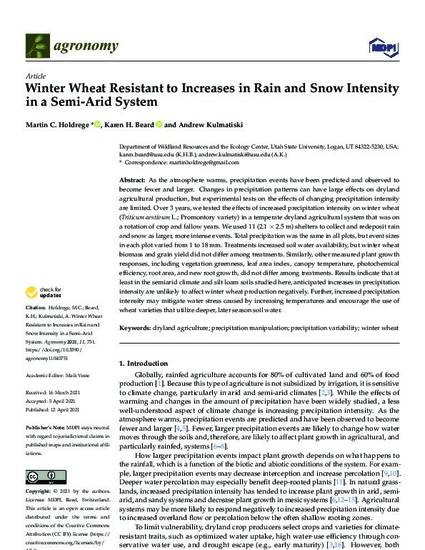
Article
Winter Wheat Resistant to Increases in Rain and Snow Intensity in a Semi-Arid System
Agronomy
(2021)
Abstract
As the atmosphere warms, precipitation events have been predicted and observed to become fewer and larger. Changes in precipitation patterns can have large effects on dryland agricultural production, but experimental tests on the effects of changing precipitation intensity are limited. Over 3 years, we tested the effects of increased precipitation intensity on winter wheat (Triticum aestivum L.; Promontory variety) in a temperate dryland agricultural system that was on a rotation of crop and fallow years. We used 11 (2.1 × 2.5 m) shelters to collect and redeposit rain and snow as larger, more intense events. Total precipitation was the same in all plots, but event sizes in each plot varied from 1 to 18 mm. Treatments increased soil water availability, but winter wheat biomass and grain yield did not differ among treatments. Similarly, other measured plant growth responses, including vegetation greenness, leaf area index, canopy temperature, photochemical efficiency, root area, and new root growth, did not differ among treatments. Results indicate that at least in the semiarid climate and silt loam soils studied here, anticipated increases in precipitation intensity are unlikely to affect winter wheat production negatively. Further, increased precipitation intensity may mitigate water stress caused by increasing temperatures and encourage the use of wheat varieties that utilize deeper, later season soil water.
Disciplines
Publication Date
2021
DOI
https://doi.org/10.3390/agronomy11040751
Citation Information
Karen H. Beard. "Winter Wheat Resistant to Increases in Rain and Snow Intensity in a Semi-Arid System" Agronomy Vol. 11 Iss. 4 (2021) p. 751 Available at: http://works.bepress.com/karenh_beard/404/
